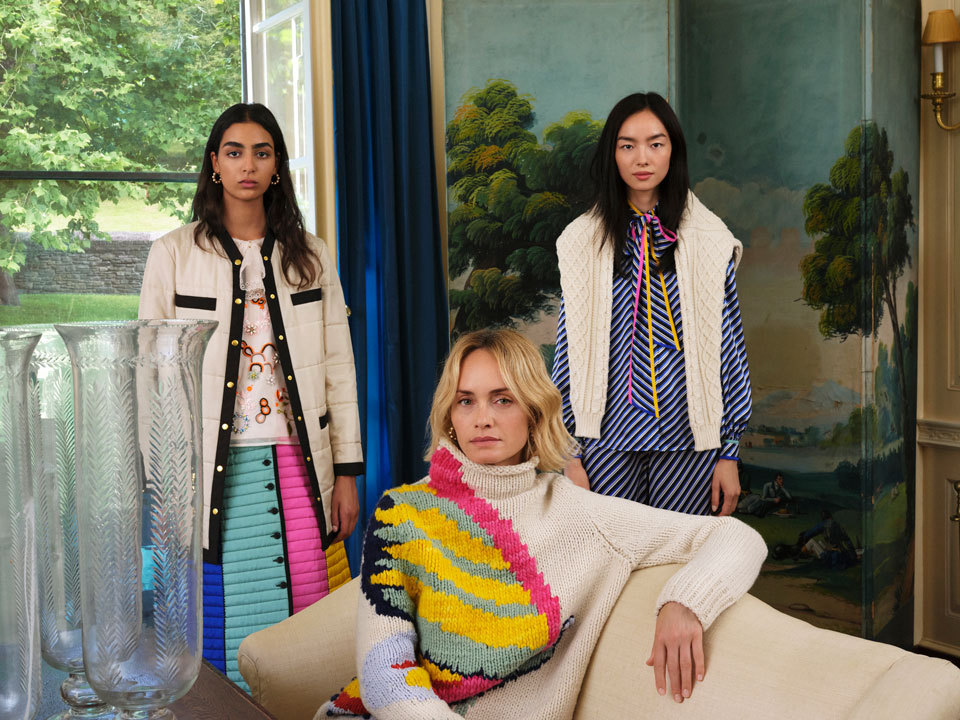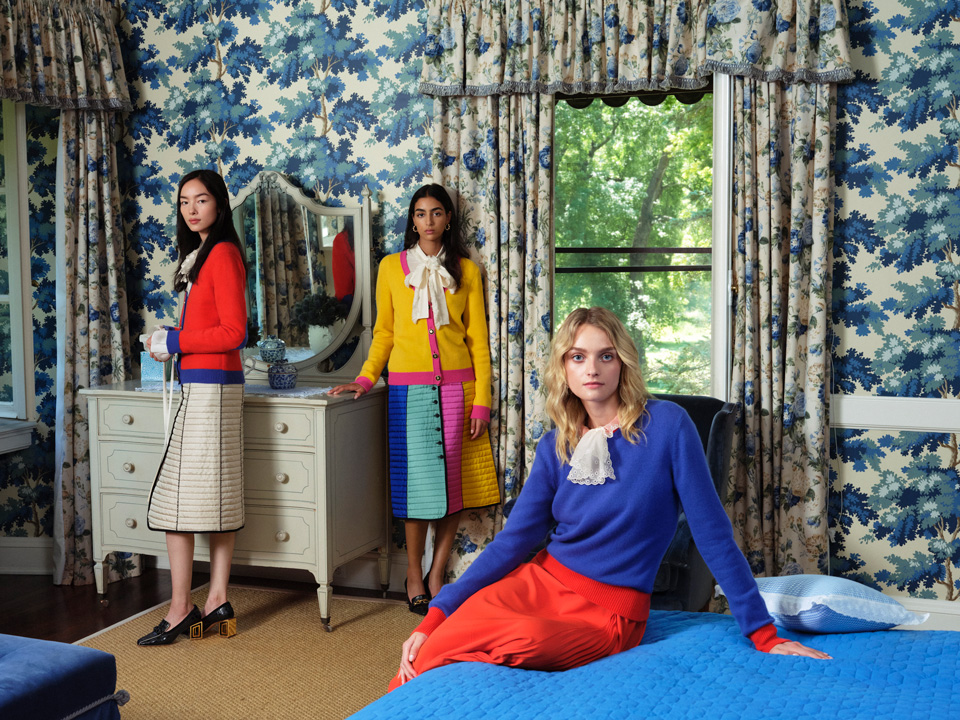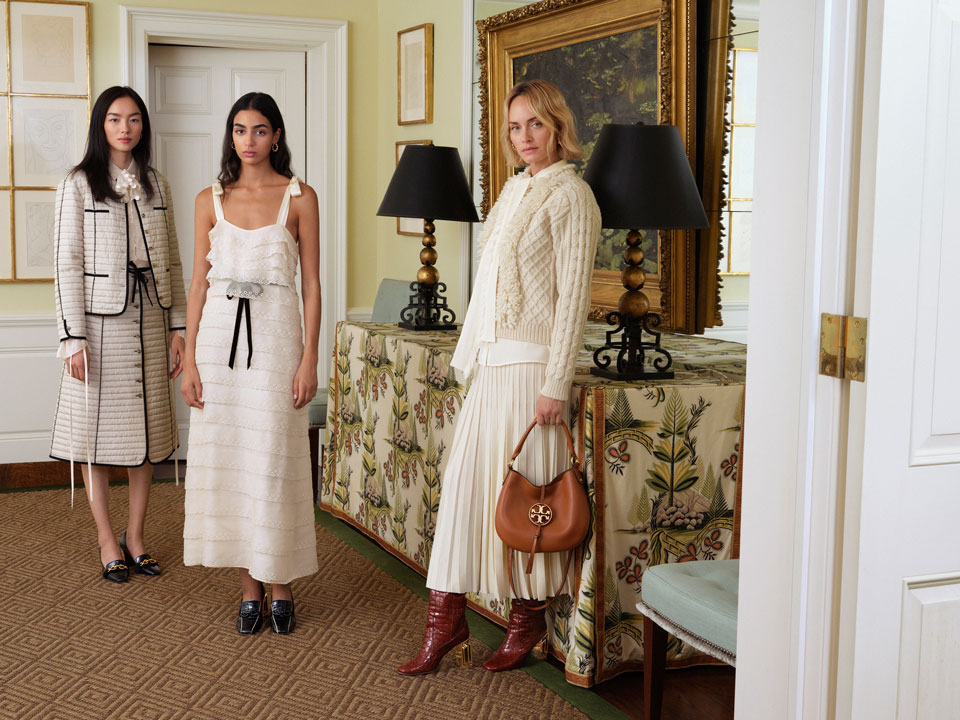
Tina Barney is known for her large-scale portraits of families and groups in unguarded moments — equally beautiful, subversive and voyeuristic. Her images have a through-the-looking-glass appeal — bringing to life her subjects’ true selves and how they interact with others when it seems like no one is looking.
In many ways, Holiday 2019 is full circle for Tina Barney and Tory Burch. Ten years ago, Tina and Tory worked together, photographing our Spring 2010 collection, capturing the color, print and joy — and perhaps a little subtext — of the clothes and the interiors, as Tory’s apartment served as the setting. Now, Tina has turned her lens on Holiday 2019. The scene is a family home in upstate New York, and the stars are a diverse cast of women — Amber Valletta, Fei Fei Sun, Nora Attal, Julia B and Franci — whose interaction with each other begs the question of their family dynamic. This is the era of the modern family. It’s what happens during the holidays when no one is looking…
But that’s all up to the viewer’s perspective. Tina herself, rarely thinks about the narrative. (Read below!) She’s obsessed with the details and framing (read below), and colors and history of the space she’s photographing in. It all seeps into the narrative the viewer creates her/himself. Below, we asked Tina about everything from her own process to her holiday plans.
What was the story you wanted to tell with Tory Burch Holiday 2019?
I do not think of a story whatsoever. I don’t think ahead of what I’m going to do. I go on instinct. There’s so much to think about in any photographing. I’m there and absorbing visually what’s happening.
How does this affect the way you interact with the talent and models on set?
As the day goes on, I learn what the women are like. I slowly feel them out to see how they move.
Empowering women is important to Tory and the company. What role do women play in your photographs?
I’m going to get burned at the stake. I never for one second think of myself as a woman. It’s not in the hemisphere of my brain. To myself, I never say, “Oh, I’m a woman.” I don’t separate the sexes. I’m just focused on the work.

The interior or the background of the set is almost more important to me than the figures or the subjects. It’s the first thing I tell my agent, “Tell me what the location is.” Without that, I can have the most spectacular subject in the world, and I can’t take an interesting picture. This house that we chose [for Tory Burch’s Holiday 2019 campaign]… It was so exciting I almost didn’t sleep that night. It was everything I had ever dreamt of. I think Tory knew it. It was indescribable. The physical space of the landscape was almost like going into a dream. But then each space inside the house… the combination of age and history and family stories and great taste and lack of pretention.
Also, things were left as is. This was after the summer and right at the beginning of winter. Big houses like this around the world, in the summer certain objects are wrapped in plastic to keep them from getting dusty over the winter. But not here, they were left as is. It’s like there was a lightning storm, and everyone just ran out of the house.
Interiors have also played a major role in your work. How has your relationship with interiors evolved since your last collaboration with Tory, in 2009?
It hasn’t changed at all. The inside space will always be the most interesting to me than outside space. Outside space is very difficult for me. The more occupied the space — with objects, furniture, stuff — the easier it is for me. A white room with white furniture, it would be hard for me. I’d be interested but it would be hard.
I have a 1778 house in Rhode Island. My mother, Lil, was a fashion model and an interior decorator, so I have that in my genes. I’ve lived in this house since I was 20 years old. It was decorated interestingly by my mother’s firm Keith Irvine and Thomas Fleming, and it looks exactly the same since then. It’s quite filled; it’s colorful. And my 400 square foot apartment in the city is clinical. It has nothing in it. It has one color — when my mother was alive it was mauve — the walls, the rug, the furniture. Now it’s light cream/yellow. The next color I’m going to do is light powder blue. I just sit there, and I’m not distracted.
Are you drawn to a certain color when you’re working?
No. It changes. Black is my most hated — photographically, it’s terrible for me. Color is my preference. When I was in my 20s, my sister and I spent a great deal of time paying attention to our clothes, then I moved out west and never got dressed up again. I probably wear the same thing every day. I barely look in the mirror.
How does color influence your mood?
It’s very important. My mother’s taste was extraordinarily focused on color. I absorbed some of that. The more colorful the better.
Please share any anecdotes about working with Tory — either in 2009 or 2019, or both!
I have done a few ad campaigns in my life and one of the hardest parts of them is the rules that you have to follow. The dos and don’ts. [Coming from editorial], it’s agony for me. I feel that with Tory, I’ve been given the most freedom. She says, ‘I trust you. Do what you want.’ The freedom that she gives me, I really appreciate.

This holiday I’m grateful for…
My kids, my family and my boyfriend (who’s 87). I have two sons and two grandkids — a boy and a girl.
Favorite holiday memory from childhood…
When I was little, we would go to Switzerland and the hotel we stayed in — the Hotel Park in Gstaad — was wonderful.
Holiday traditions I look forward to most…
Spending time with my grandchildren and sons. Being with family. We don’t do anything big or fancy…
I know it’s the holiday season when…
I don’t think about it too much. Mainly because we go to one place and are together. We go to Idaho.
Favorite holiday book, movie or song…
“White Christmas” with Bing Crosby.
